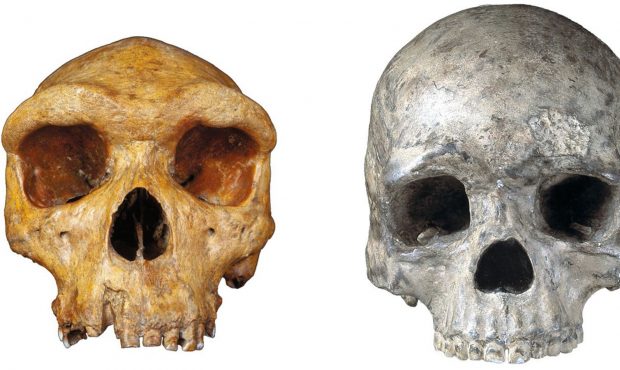This could be why our eyebrows evolved
Apr 9, 2018, 2:42 PM | Updated: Jun 7, 2022, 4:00 pm

On the left is a fossilized skull of our hominin ancestor Homo heidelbergensis, who lived 200,000 to 600,000 years ago. On the right is a modern human skull.
(CNN) — If we could meet our human ancestors from hundreds of thousands of years ago and have a conversation with them, we might think they were angry and aggressive — just by looking at their eyebrows.
Hominins like Homo heidelbergensis, who lived 200,000 to 600,000 years ago, had a very pronounced brow ridge. This gave their facial appearance an aggressive look, which helped establish dominance. Researchers have compared these to antlers on male deer.
But modern humans evolved to have a smooth forehead with very mobile, expressive and hairy eyebrows. So what happened, and why do we have these eyebrows, as opposed to the brow ridge?
In the past, researchers have proposed that the brow ridge served a practical function. They have suggested that it filled the space between the brain case and eye sockets or acted as a stabilizer for the skull to withstand the force of chewing on the tough materials our ancestors ate.
The researchers behind a new study, published Monday in the journal Nature Ecology and Evolution, propose a different theory: As in the features of other primates, such as the brightly colored faces of mandrills, the brow ridge was more of a social signal of dominance, aggression and a sexually differential display rather than a practical support system in the skull.
Facial evolution
Over the past 100,000 years, our faces gradually became smaller, compared with those of Neanderthals and the earliest humans. As our foreheads smoothed and grew flatter, we developed eyebrows, rather than the brow ridge. This happened in conjunction with the growing need for communication skills to establish social networks as populations expanded.
Eyebrows that could move and express the nuances of emotion, like recognizing someone or showing sympathy, could pave the way of understanding or cooperation even across language barriers.
The researchers, from the University of York in the UK and the Universidade do Algarve in Portugal, used 3-D engineering software and virtual scans of the iconic Homo heidelbergensis skull, Kabwe 1, to study the brow ridge. They used a Neanderthal mandible to complete the skull in their simulations.
The modeling software enabled them to simulate different theories and situations, like the force of chewing and biting down on different teeth or the structural integrity of the skull with the ridge and without the ridge.
“The key impact is the discovery that the massive brow ridge of this fossil, our last ancestor, is not simply explained by spatial requirements or as a stiffener of the face to help it resist strong biting forces,” Paul O’Higgins, study senior author and professor of anatomy at the University of York, wrote in an email. “This leads us to revisit the social hypothesis — that it is so much larger than it needs to be because it fulfills a role in social communication — most likely to communicate dominance/aggression.”
If our need to survive relied more and more on communication, this evolution would be plausible, the researchers said.
“As we developed smaller faces that came to lie more directly beneath the brain, our flatter more vertical foreheads would have subtly altered the function of the muscles that pass over the skull and attach to the skin of the brows — in that these muscles would now raise brows more vertically rather than draw them back over the brow ridge — mobile eyebrows over the more vertical ‘canvas’ of the forehead, allowing a greater range of movement, likely important in social communication,” O’Higgins said.
The eyebrows have it
It’s hard to know all of the ways people use their eyebrows in a single day, largely because we can’t see ourselves or our facial expressions. But they can have a large impact on those we interact with. The eyebrows pull up at the middle when people want to express sympathy, and other tiny movements can signify components of deception or trustworthiness.
The researchers cite the “eyebrow flash” as an example of this type of communication. It’s that familiar movement in our eyebrows that lasts only a fraction of a second but conveys that we recognize someone at a distance or shows signs of friendliness.
“Being able to make subtle emotional expressions, and at a distance is likely to have helped in a major social transformation in how unrelated groups of people worked together,” Penny Spikins, study co-author and senior lecturer in the Department of Archaeology at the University of York, wrote in an email. “It is only after the emergence of our species, and this facial change, that we see exchanges of gifts across large areas in the archaeological record, which is likely to have cemented friendships which provided backups in hard times and colonisation of new and difficult regions, for which a ‘fall back’ in terms of distant friends may have been important.”
During this time, prehistoric modern humans began to actively diversify their groups to avoid inbreeding or stay with friends during difficult times, Spikins said. This also shows that humans wanted to get along, form relationships and express emotions, rather than compete — sometimes called self-domestication, she said.
The researchers believe that these additions to communicating with each other, like expressing emotions using eyebrows, help fill in one of the blanks as to why modern humans cooperated better than the hominins who went extinct.
Going forward, they’re interested in studying how this tolerance developed. O’Higgins is also interested in studying the origins of sociality by studying muscular anatomy and function in apes and humans.
Markus Bastir, a researcher with the Museo Nacional de Ciencias Naturales’ department of paleobiology in Madrid, wrote an article to pair with the study, outlining possible concerns with the research as well as highlighting some of its strengths.
“My biggest concern is that bones of two different hominin species were combined, a H. heidelbergensis (or H. rhodesiensis) cranium with a Neanderthal mandible,” Bastir wrote in an email. “This is a bit strange given the abundance of biologically more appropriate mandibles available in the fossil (and digital) record.
“The greatest strength is that the authors used cutting edge virtual morphology to carry out computer experiments on functional morphology. … It further draws our attention to a potentially new facet of sociality in human evolution.”
The-CNN-Wire
™ & © 2018 Cable News Network, Inc., a Time Warner Company. All rights reserved.













